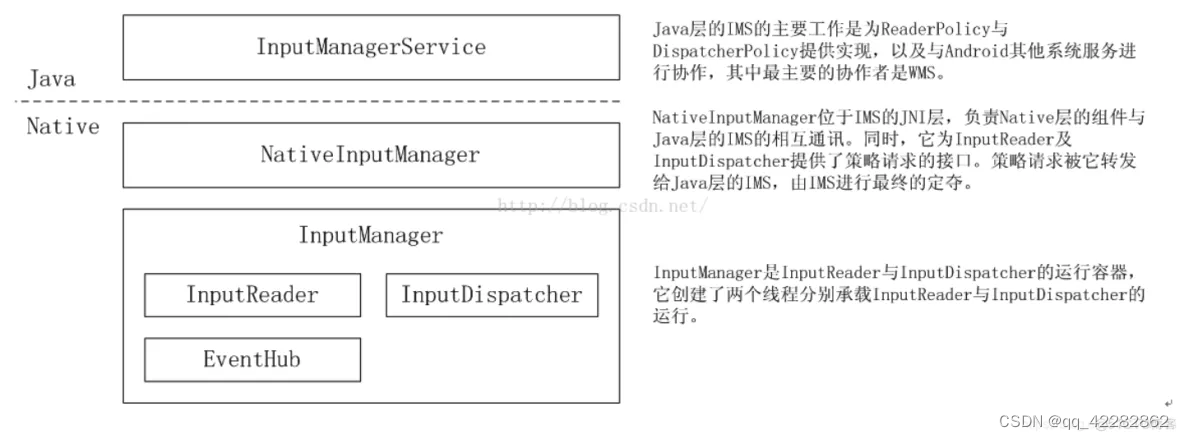IMS的整体架构diagram

输入事件的源头位于、dev/input下的设备节点,输入系统的终点是由WMS管理的某个窗口。Android输入系统的功能是读取设备节点中原始事件,加工封装后派发一个特定的窗口以及窗口控件,及扫描输入设备将设备封装到mDevices数组。
| 模块 | 模块说明 |
|---|---|
| linux 内核 | 接受输入设备中断,将原始事件数据写入到设备节点 |
| 设备节点 | IMS可以从中读取事件 |
| InputManagerService | 分为Java层和native层两部分,Java层负责与WMS的通信;Native层是InputReader和InputDispatcher两个输入系统关键组件的运行容器 |
| EventHub | 直接访问所有的设备节点,通过一个名为getEvent()的函数将所有输入系统相关的处理底层事件返回给使用者 |
| InputReader | 运行于独立线程,负责管理输入设备的列表和配置,以及进行输入事件的加工处理。通过线程循环不断地通过getEvent()函数从EventHub中将事件取出并进行处理。对于设备节点的增删事件,他会更新输入设备列表于配置。对于原始输入事件,InputReader对其进行翻译,组装封装包含更多的信息,然后交给InputDispatcher进行派发。 |
| InputReaderPolicy | 为InputReader事件加工处理提供策略配置 |
| InputDispatcher | IMS的另一个组件。它也运行在一个独立线程中,InputDispatcher中保管了来自WMS所有窗口的信息,收到来自InputReader的输入事件后,会寻找合适的窗口,将事件派发给它。 |
| InputDispatcherPolicy | 它为InputDispatcher的派发过程提供策略控制 |
| WMS | 对InputDispatcher的正常工作起到了重要作用。新建窗口时,WMS为新窗口和IMS创建了事件传递所用的通道。另外,还将所有窗口的信息,包括窗口的可点击区域,焦点窗口等信息,实时更新到IMS的InputDispatcher中,使得InputDispatcher可以正确地将事件派发到指定窗口。 |
| ViewRoot | 对于某些窗口,如壁纸窗口,SurfaceView的窗口来说,窗口即是输入事件派发的终点。而对于其他的Activity,对话框等使用了Android控件系统的窗口来说,输入事件的终点是控件(view)。ViewRootImpl将窗口所接受到的输入事件沿着控制树派发给View |
内核将原始事件写入到设备节点中,InputReader不断地通过EventHub将原始事件取出来并加工成Android输入事件,交给InputDispatcher。InputDispatcher根据WMS提供的窗口信息将事件交给合适的窗口。窗口的ViewRootImpl对象再沿着控件树将事件派发给具体的控件。控件对其收到的事件作出响应,更新自己的画面、执行特定的动作。
IMS启动流程分析
Android的输入子系统是在InputManagerService启动的,而InputManagerService是在system_server中启动的。接下来从SystemServer的启动开始逐步分析:
//systemserver->startOtherServices
private void startOtherServices() {
//...
inputManager = new InputManagerService(context);//关键点1
wm = WindowManagerService.main(context, inputManager,
mFactoryTestMode != FactoryTest.FACTORY_TEST_LOW_LEVEL,
!mFirstBoot, mOnlyCore);
ServiceManager.addService(Context.WINDOW_SERVICE, wm);
ServiceManager.addService(Context.INPUT_SERVICE, inputManager);
inputManager.setWindowManagerCallbacks(wm.getInputMonitor());
inputManager.start();//关键点2
}
InputManagerService
public InputManagerService(Context context) {
this.mContext = context;
this.mHandler = new InputManagerHandler(DisplayThread.get().getLooper());
mUseDevInputEventForAudioJack =
context.getResources().getBoolean(R.bool.config_useDevInputEventForAudioJack);
Slog.i(TAG, "Initializing input manager, mUseDevInputEventForAudioJack="
+ mUseDevInputEventForAudioJack);
//调用nativeInit来执行C++层的初始化操作
mPtr = nativeInit(this, mContext, mHandler.getLooper().getQueue());
LocalServices.addService(InputManagerInternal.class, new LocalService());
}
com_android_server_input_InputManagerService.cpp
static jlong nativeInit(JNIEnv* env, jclass clazz,
jobject serviceObj, jobject contextObj, jobject messageQueueObj) {
sp<MessageQueue> messageQueue = android_os_MessageQueue_getMessageQueue(env, messageQueueObj);
if (messageQueue == NULL) {
jniThrowRuntimeException(env, "MessageQueue is not initialized.");
return 0;
}
//构造一个NativeInputManagera对象
NativeInputManager* im = new NativeInputManager(contextObj, serviceObj,
messageQueue->getLooper());
im->incStrong(0);
return reinterpret_cast<jlong>(im);
}
这里创建一个NativeInputManager的实例,并将其作为返回值保存在InputMangerService的mPtr字段里,继续分析NativeInputManager的构造器。
NativeInputManager::NativeInputManager(jobject contextObj,
jobject serviceObj, const sp<Looper>& looper) :
mLooper(looper), mInteractive(true) {
JNIEnv* env = jniEnv();
mContextObj = env->NewGlobalRef(contextObj);
mServiceObj = env->NewGlobalRef(serviceObj);
{
AutoMutex _l(mLock);
mLocked.systemUiVisibility = ASYSTEM_UI_VISIBILITY_STATUS_BAR_VISIBLE;
mLocked.pointerSpeed = 0;
mLocked.pointerGesturesEnabled = true;
mLocked.showTouches = false;
}
//构造一个EventHub对象,InputReaderPolicy,InputDispatcherPolicy,传递给InputManager
sp<EventHub> eventHub = new EventHub();
mInputManager = new InputManager(eventHub, this, this);
}
这里继续分析关键对象InputManager,代码如下:
InputManager::InputManager(
const sp<EventHubInterface>& eventHub,
const sp<InputReaderPolicyInterface>& readerPolicy,
const sp<InputDispatcherPolicyInterface>& dispatcherPolicy) {
mDispatcher = new InputDispatcher(dispatcherPolicy);
mReader = new InputReader(eventHub, readerPolicy, mDispatcher);
initialize();
}
这里创建了一个InputReaderThread和InputDispatcherThread对象,前面构造器中创建InputReader是通过InputReaderThread来读取输入事件,而InputDispatcher实际通过InputDispatcherThread来发输入事件。

InputManager的创建过程分别为InputReader与InputDispatcher创建了线程,IMS的成员准备就绪。
InputManagerService线程启动分析
线程启动
inputManager.start();
---------------------------------------
public void start() {
Slog.i(TAG, "Starting input manager");
nativeStart(mPtr);
//...
}
----------------------------------------
static void nativeStart(JNIEnv* env, jclass /* clazz */, jlong ptr) {
NativeInputManager* im = reinterpret_cast<NativeInputManager*>(ptr);
status_t result = im->getInputManager()->start();
}
---------------------------------------
status_t InputManager::start() {
status_t result = mDispatcherThread->run("InputDispatcher", PRIORITY_URGENT_DISPLAY);
//...
result = mReaderThread->run("InputReader", PRIORITY_URGENT_DISPLAY);
//...
return OK;
}
InputManager启动了一个InputReaderThread和InputDispatcherThread来读取和分发消息,调用run之后,会进入threadLoop函数。这里start()函数的功能就是启动这两个线程,使得InputReader于InputDispatcher开始工作。当两个线程启动后,InputReader在其线程循环中不断地从EventHub中读取输入事件,加工处理后将事件放入InputDispatcher的派发发队列中,InputDispatcher在线程循环中将派发队列中的事件取出,查找合适窗口,将事件写入。窗口事件接收线程的Looper从管道中将事件取出,交由事件处理函数进行事件响应。

























 718
718











 被折叠的 条评论
为什么被折叠?
被折叠的 条评论
为什么被折叠?








